Pierre-Émile Martin
- Born:
- Aug. 18, 1824, Bourges, Fr.
- Died:
- May 23, 1915, Fourchambault (aged 90)
Pierre-Émile Martin (born Aug. 18, 1824, Bourges, Fr.—died May 23, 1915, Fourchambault) was a French engineer who invented the Siemens–Martin (open-hearth) process, which produced most of the world’s steel until the development of the basic oxygen process.
While the chemistry of steelmaking was already familiar in 1856, the only practical method, the Bessemer process, had many serious drawbacks. In that year the English engineer Sir William Siemens invented the open-hearth furnace, which could produce and sustain much higher temperatures than any other furnace. Martin obtained a license to build such furnaces and developed a method of producing steel by using scrap steel and pig iron. His steel products were awarded a Gold Medal at the Paris Exhibition of 1867. Although Siemens developed his own method of steel production with his open-hearth furnace, the Siemens-Martin process eventually became the most widespread.
Martin’s patents on his process were challenged, and the ensuing litigation reduced him to virtual poverty. Others were making large profits using his process, however, and finally, when Martin was 83 years old, the Comité des Forges de France (“Ironworkers Guild of France”) instituted a fund for him that was supported by all of the principal steelmaking countries. Barely one week before Martin’s death, the Iron and Steel Institute, London, honoured him with its Bessemer Gold Medal.














